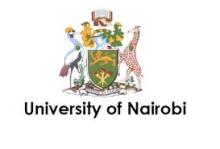Resource information
This paper presents data on diversity and abundance of soil macrofauna of various land use systems in Embu, Kenya (natural forest, plantation forest, fallow, coffee, tea, napier, and maize). Each was sampled for macrofauna using three sampling methods (monolith,
transect and pitfall traps). Thirty four (34) genera/species of soil macrofauna were recorded, the highest number (27) being observed in napier. Majority of these genera/species being Coleoptera. Rényi diversity profile indicated that in terms of
species richness (α at 0), maize was the richest of all the land use systems, but plantation forest the least. It was however not possible to clearly order or rank the land use system in terms of diversity because of the bias of each of the two diversity indices as indicated
by the numerous crossings observed for the diversity profiles/curves. Shannon index of diversity (α = 1) indicated that coffee was the most diverse of the land use systems followed by plantation forest > natural forest > napier > maize > tea, while fallow/pasture was the least diverse (Figure 1). On the other hand, Simpson’s diversity (α = 2) indicated that plantation forest was the most diverse followed by fallowed by coffee > natural forest > napier > maize >tea > fallow/pasture. Rényi evenness profile indicated that the plantation forest was most even in terms of species distribution followed by natural forest and coffee > napier > tea > maize but least even in the fallow/pasture. Hymenoptera were most abundant of the macrofauna groups constituting about 45% of the total followed by Isoptera (39%), Coleoptera (6%), Oligochaeta (5%), Orthoptera (3%) and Arenae (2%).
The other groups that comprised of Hemiptera, Diptera, Phasmidae and Blattelidae each constituted <1% of the total marofauna recorded. Highest macrofauna density (1566) was recorded in the napier followed by fallow (1356) > coffee (1170) > natural forest (1110) > tea (755), but lowest in plantation forest (309), although analysis of variance indicated no
significant variation among the land use systems. This study however, demonstrates that quantitative changes in diversity and density of soil fauna communities occur when various land use systems are subjected to varying levels of intensification. These changes appear to be associated with management practices such as use of agrochemicals, consequent destruction of nesting habitats, modification of soil microclimate within habitats, removal of substrate, low diversity and availability of food sources for the associated macrofauna groups. The significant correlations between some soil macrofauna groups with selected soil chemical properties shows that, soil chemical characteristics may indirectly play a role in influencing the density, distribution and structure of macrofauna communities.
Key words: Macrofauna; diversity; abundance; land
use systems


